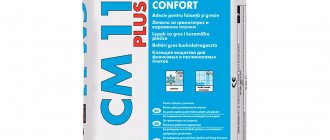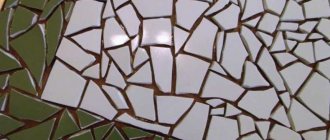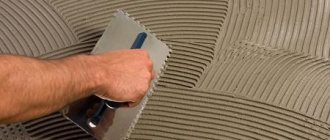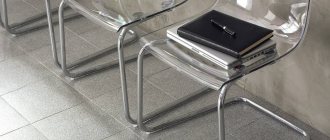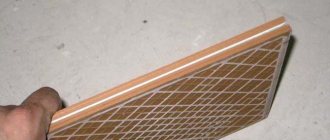Manual tile cutter - used for straight and diagonal cutting of ceramic tiles and porcelain stoneware, with a cutting depth of up to 15 mm.
Manual (roller) tile cutters can be divided into two types - these are monorails and where the moving block runs along two guides, in the form of tubes (on bushings or bearings), the second option is more reliable.
You can also pay attention to water-cooled electric tile cutters
What to look for when choosing:
- Size (platform length) - when cutting large tiles, you need an appropriate size tile cutter;
- Ballerina is an additional circular cutter for holes for sockets and switches;
- Rigidity of the frame and guides - the structure should not bend much;
- The presence of a protractor - for a more accurate cutting angle;
Rating of tile cutters
A simple tile cutter is often used at home: for cutting bathroom and kitchen tiles. On an industrial scale, you need a tile cutter for tiles made of high-strength materials: porcelain stoneware, clinker, natural stone.
Pay attention to the size of the bed, the number and type of guides, and the reliability of the carriage. It depends on them how long the device will last, how much effort you put into cutting and how evenly the tiles will be cut.
We have selected a number of criteria that professional craftsmen consider important:
- Power;
- Maximum depth;
- Cut length;
- Purpose;
- Engine location;
- Functionality;
- Carriage quality.
Users note that for frequent use, you need to choose a model with a reinforced frame and a reinforced handle. In household use, electric tile cutters with a bottom-mounted motor are usually used, as they are ergonomic and fast, or semi-professional manual tile cutters with rulers.
Design features
To cut any type of tile, manual devices are used, but an electric one is also a good option.
Regardless of what type of device is chosen, you need to get acquainted with its technical characteristics:
- The machine must be well assembled, the parts are made of
- According to the instructions, check the parameters of the engine, what power it is endowed with, it will be required to complete the required volumes, in accordance with the thickness and hardness of the plates to be cut.
- It’s good if the model can cut parts with angular adjustment.
- Its performance depends on the quality, purpose, and type of diamond disc.
- A complete set of spare parts is required; if a breakdown occurs, you can immediately replace it.
All devices must first of all be simple and easy to use.
The best electric tile cutters
Electric tile cutters are designed to work with tiles, porcelain stoneware, and stone in wide areas. They are hardy, fast and wear-resistant. The VyborExpert.ru team has prepared reviews of 3 reliable models.
Bison EP-180-600N
The asynchronous motor has protection installed: after a new voltage supply, an electromagnetic switch is triggered. If the device does turn on, the protective cover on the roller will protect you from injury.
Suitable for cutting floor and wall tiles in renovation and construction work, in a workshop or small production. Thanks to the wide edgeless bed, you can cut tiles of any size and from a wide variety of materials, except asbestos-containing ones.
Compact dimensions with a bottom-mounted engine allow the tool to be located in a small space. Effective water cooling eliminates dust and debris and prevents the roller from overheating or damaging the tiles.
To connect to the network, a standard voltage of 220 V is required. Almost 3000 revolutions per minute - this is the specific power of a rotating roller with a diameter of 18 centimeters. With such characteristics there is no need to make multiple passes. The roller cuts from 1.7 to 3.4 cm on the fly - and this is at angles.
You can rotate the guide in any convenient way to get a straight, oblique or combined cut. When turned off, the carriage is easy to press, but there is no vertical movement.
Advantages:
- Manufacturer's warranty – 5 years;
- Suitable for any tiles;
- Sawing at different angles;
- High speed;
- Compactness;
- Low price.
Flaws:
- If you do not work carefully, the edge of the tile breaks off;
- Lots of splashes.
The design contains a container for supplying liquid. It needs to be changed periodically when cutting. Detailed information is provided in the instruction manual.
Elitech PE 800/62Р
Used by both professionals and amateur craftsmen. A powerful 800 W electric motor is capable of accelerating the diamond roller to 2950 rpm at a voltage of 230 V. Thanks to its wide diameter of 20 cm, the roller cuts tiles of all types and sizes.
Possessing remarkable power, the tile cutter cuts up to 3.6 cm deep. High power combined with vertical and horizontal mobility makes the model accurate, reliable, and convenient.
The tool can be placed at a distance of 10 meters from the outlet thanks to the long power cord. It can cope even with high loads: repairing the facade of a building, laying tiles in large volumes.
Advantages:
- High performance;
- Folding legs, wheels;
- High-quality assembly;
- Easy carriage movement;
- Smooth start;
- Professional.
Flaws:
- Rapid wear of rubber in the work area;
- Lots of splashes.
The tile does not vibrate during operation - thanks to the rubber coating. The water hose is protected by corrugations. The basic disc is of quite high quality, it copes with porcelain tiles with a bang!
Rubi du-200 evo 650
If you have already completed the intermediate level with tools and need an electric tile cutter, you can buy this model. It is expensive - it costs about 40 thousand and is difficult to get. However, it cuts tiles perfectly during finishing work. With a speed of 2915 rpm and a cutting depth of 3.5 cm, it is capable of cutting even thick gres.
Water cooling, high power, 20 cm disk... The model has it all. A special feature is the top position of the motor, in which the cutting unit moves along a guide and cuts different types of ceramic tiles. The saw blade is covered with a casing to prevent traumatic situations, protection from dust, sparks, and splinters.
Four foldable legs and two caster wheels ensure ease of installation and storage, as well as stability of the structure on the surface. A removable external tank prevents the disk from overheating. Cuts tiles within 60x60.
Advantages:
- Mobility;
- Lightness;
- Cuts porcelain tiles;
- Convenient disc change.
Flaws:
- High price;
- Vibration from the legs affects the cut.
Professionals suggest immersing the cooler pump in a bucket of water so as not to create a “water cycle”. This eliminates water contamination and engine overheating.
Getting to know the tools
Before you start studying the rating of the best electric tile cutters, you need to get acquainted with their manual counterparts.
Basic elements of a tile cutter.
Basic elements of a tile cutter
If a professional device is selected:
- roller;
- mechanical;
- bearing - it will be durable in design and will cut directly in the direction chosen by the tiler.
When buying a device, consider:
- how strong is the frame;
- what is its length;
- base rigidity;
- strength of handles;
- level of smoothness.
The advantages of hand-held devices include the following qualities:
- compactness;
- independence from power supply;
- free movement.
For larger volumes, use an electric cutter. They differ in the lower and upper location of the engine, and perform operations with greater accuracy, speed, and have less waste, in contrast to the losses that a manual machine makes. When cutting to size, porcelain tiles often burst in unnecessary places due to temperature and load. Splitting is prevented by water and air cooling, which prevents parts from overheating and failure, while neat, undamaged cuts are made.
The best cordless tile cutter
The water-cooled cordless tile cutter is self-contained, high-performance and compact. It doesn’t need a power outlet, just charge the battery and move it anywhere. Thanks to the adjustable cutting depth, it is able to accurately cut tiles.
Makita cc301dwae
A small machine that deftly cuts 1.1 cm thick porcelain tiles. With a sharp 85mm diamond roller and a stainless nickel soleplate, it is a convenient, portable device for precise cutting. Cuts thoroughly and accurately, at a speed of 1600 rpm.
In the upper part there is a water container for wet cutting - dust and crumbs will not linger on the table. All excess water will drain into the built-in tray. The clarity of the corners is ensured by an angular cut, up to tiles measuring 80x80 cm. If the marking line is dirty, it will be cleaned using the blowing function.
The special feature is the rechargeable lithium-ion battery. There is no need to place the tile cutter closer to the outlet - its mobility will allow you to carry it to small finishing events. However, experts recommend purchasing a suitcase. Although the weight is only 2 kg, there is a risk of damage to parts in the box.
Thanks to the rubberized handle, you can hold it with thick gloves - this will ensure difficult sliding due to the adhesion of the rough fabric to the smooth surface of the rubber.
Advantages:
- Quick replacement of nozzle;
- Ease of management;
- No backlash;
- Cutting precision;
- High-quality factory disc;
- Low noise level.
Flaws:
- Slow cutting of porcelain tiles;
- Weak water pressure.
The instructions indicate that the tile cutter is actually a glass cutter - intended for glass decorative tiles, but craftsmen also recommend it for ceramics, granite, and tiles, if you have enough patience.
Principle of operation
Manual tile cutters are mechanical tools.
Their operating principle is similar to a glass cutter. The tools are compact in size and light in weight. They are easy to carry. The material is carved by a protruding roller, which is driven manually using a special handle. It is mounted on a carriage mounted on the tile cutter bed.
Pressing the handle creates a roller load on the material being processed, which leads to its breaking along the cutting line. The horizontal movement of the roller is ensured by a rail mechanism mounted on the frame.
It may consist of:
- From an I-beam.
- 2 parallel tubes.
The material to be processed for cutting is placed on the base of the bed, equipped with special shock-absorbing pads. The tile cutter itself must stand on a hard surface while working. During cutting, the roller rubs against the material, causing it to heat up. To cool it and prevent dust formation during operation, tile cutters are equipped with water reservoirs. Some models are equipped with a rotating ruler.
How to choose a tile cutter
Tile cutters are divided into mechanical and electric. Mechanical can be pencil, wire cutters, traditional, patterned. Electric – motor, battery. The main differentiation occurs by the type of device, its dimensions or compactness, ease of transportation and installation.
The VyborExperta.ru team offers a closer look at the design of traditional mechanical and electric tile cutters.
Purpose
Manual tile cutters are rated by weight, handle comfort and cutting surface area. They are designed for cutting thin facing materials: tiles, glass, ceramic tiles. Depending on the sharpness and material of the blade, the thickness of the tile, it can be cut in 1 or several passes. The tile breaks on the stop.
Electric tile cutters cut tiles more than 1 cm thick: porcelain stoneware, faience, gres, natural stone in large quantities. One 2-5 minute pass is enough for this tile cutter. They often have a titanium-coated steel disc or a diamond disc built into their base. Can be a replacement for a circular saw if water-cooled. They come with a removable and fixed frame; with upper and lower engine; with air and water cooling.
Power
Tile requires 750–1500 W, while granite and marble require a couple of kilowatts. The diameter of the diamond blade is directly related to the power: in the first case, the cut is provided with a diameter of 230–250 mm, in the second you will need a 350 mm wheel. The size of the machine also depends on the power. Heavy is required only for working with stone.
Limit depth
3.5 cm is enough to provide a cut up to 1.35 cm thick. Typically, the cutting depth ranges from 0.4–1.1 cm with an adjustable height.
To cut more than 0.1 cm, a budget electric tile cutter with bottom-mounted motors is required. It is suitable for smooth straight cuts and cuts on the end side.
For cutting tiles during renovations, a tile cutter with a water cutting depth of 1.5-2 cm is suitable, depending on the thickness of the tile.
Cut length
The size of the cut tile depends on the length of the guide and the dimensions of the platform. Machines designed for cutting stone have impressive formats. In fact, the length of the cut is often less than that indicated in the passport, usually taken with a reserve.
By removing the clamps, you can increase the length, but the ease of use will decrease. In some models, the table expands due to support brackets and additional platforms.
Brief overview - how to cut tiles
Each person was a participant in a simple or major repair. Some built houses where finishing was the final stage. When laying tiles, so that there are no gaps in places where it is impossible to fit a whole square, small blanks are placed. You can prepare them by cutting them to size.
To do this, they use tile cutters, which all, even the best ones, are designed to perform specific actions. Their effectiveness depends on various reasons, but you need to know the most important ones.
Tiles come in different materials:
- stone;
- tiled;
- glass;
- porcelain stoneware;
- clinker;
- rubber;
- Metlakhskaya
Ceramics differ in color and shape.
Ceramics vary in color and shape
Different installations by area:
- floor;
- wall;
- ceiling;
- sidewalk;
- façade;
- decorative.
Ceramic tile
Floors, walls and ceilings are tiled.
Ceramics are classified by type, but they are all united by cutting according to size; without them, finishing walls or floors will become meaningless. When gluing, a specific surface is filled with prepared forms, blanks, and in places of contact you will have to adjust them, add or cut the plate.
Tile cutter
A tile cutter can cut ceramics correctly and evenly.
Fragile elements need to be cut with straight edges. Why use a tile cutter, preferably the best one, even its name indicates its purpose. The tool not only cuts the material according to the desired configuration, but at different angular inclinations.
Therefore, when buying such a device, take into account the quality of its components:
- cutting elements;
- goniometers;
- floating bases;
- guides.
The ability to quickly, evenly cut facing and flooring sheets depends on the hard steel roller.
The rating of electric tile cutters helps to choose them correctly. Such a list is compiled based on user reviews and expert data obtained from the results of checks for compliance with operational characteristics.
Which tile cutter is better
When considering which tile cutter to buy for your home or business, pay attention to cost and variations in features. Each device has a frame, guides, a lever or handle, and a carriage. Stationary options have additional functions: cooling, blowing markings, expanding the table, collecting water in a tray, battery operation, splitting tiles against a stop.
The VyborExperta.ru team has selected a number of the best nominees:
- For precise long cuts of tiles and leisurely repair work, we recommend the Bosch PTC 640;
- The work will go more efficiently and quickly if you take the budget Bison EP-180-600N, popular among craftsmen;
- If you need an accurate, mobile, but leisurely tool for small finishing work, the Makita cc301dwae is suitable.
The main element of the cut is the roller: the mechanical one is very hard, made of galvanized aluminum alloy; the electric versions have a diamond or titanium-coated disk, which increases its sharpness and accuracy. Rely not only on the model’s character, but also on your own - you like fast or leisurely work, you are used to working for quality or quantity. Choose a model based on your character.
Criterias of choice
Tool type . There are electric and manual tile cutters. The first type is suitable for large volumes of work and frequent use, but its cost is several times higher than the second, which will be ideal for rare use.
External defects . Their presence is determined visually. Even if the tool is used, it should not have serious scratches or cracks. In addition, this also includes testing the motor - when purchasing a tile cutter with one, you need to turn on the device and listen carefully so that there are no vibrations and the sound is even.
Spare parts. If they are included in the kit, then this device is worth paying attention to. Spare parts will help out when the device breaks down at the most unnecessary moment and you need to replace one or another part.
Results
Choosing a future tile cutter is quite complicated, and therefore it will be better if all the main criteria are taken into account. These include not only ease of operation, but also the ability to cut almost any tile and shape of the device. Be sure to consider how often you plan to use the tile cutter, as well as what tiles you will be working with most often.
Our article presents the most popular, high-quality and not too expensive tile cutters, which were evaluated by both experts and real buyers. Having purchased any model from our rating, you can be sure of its quality.
